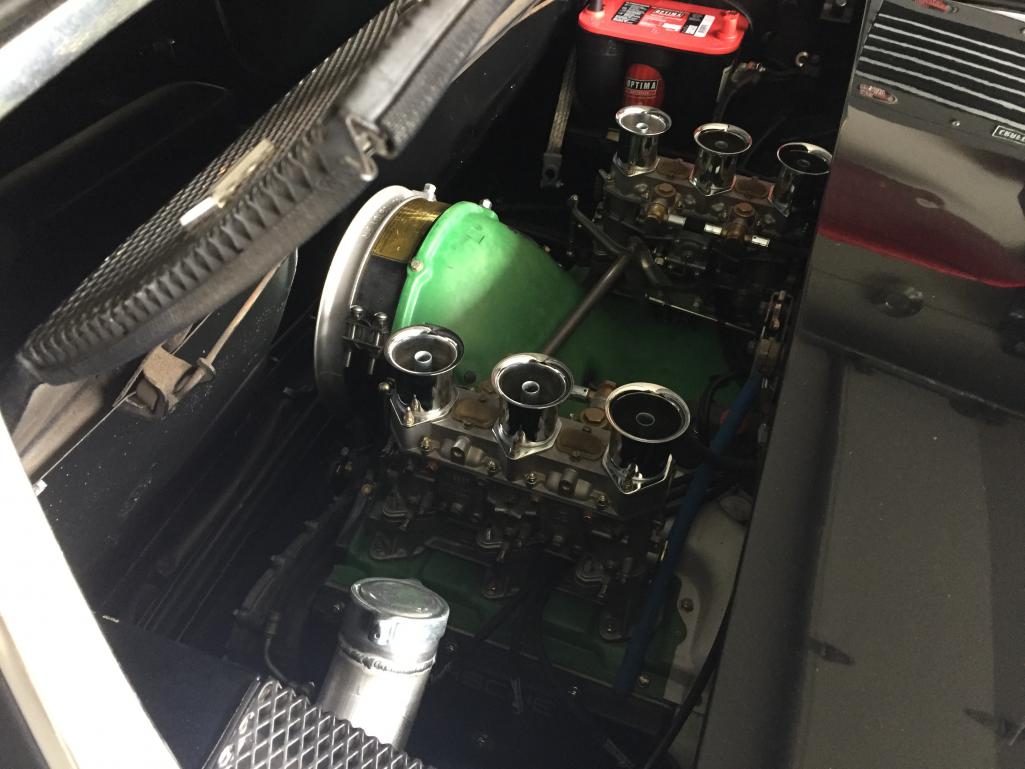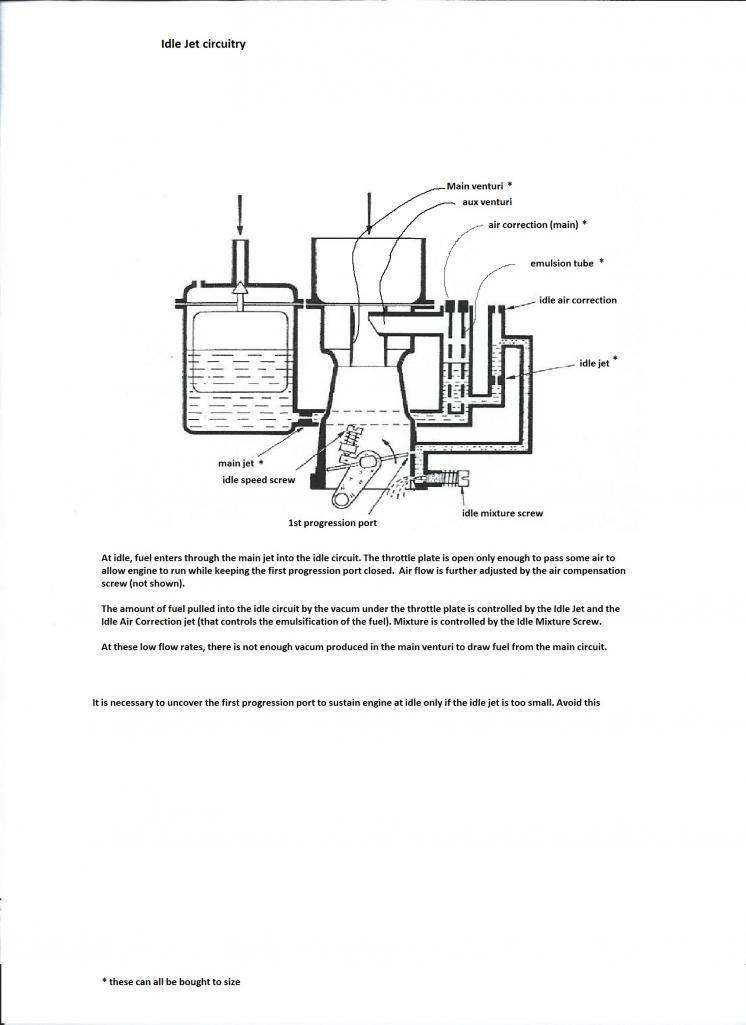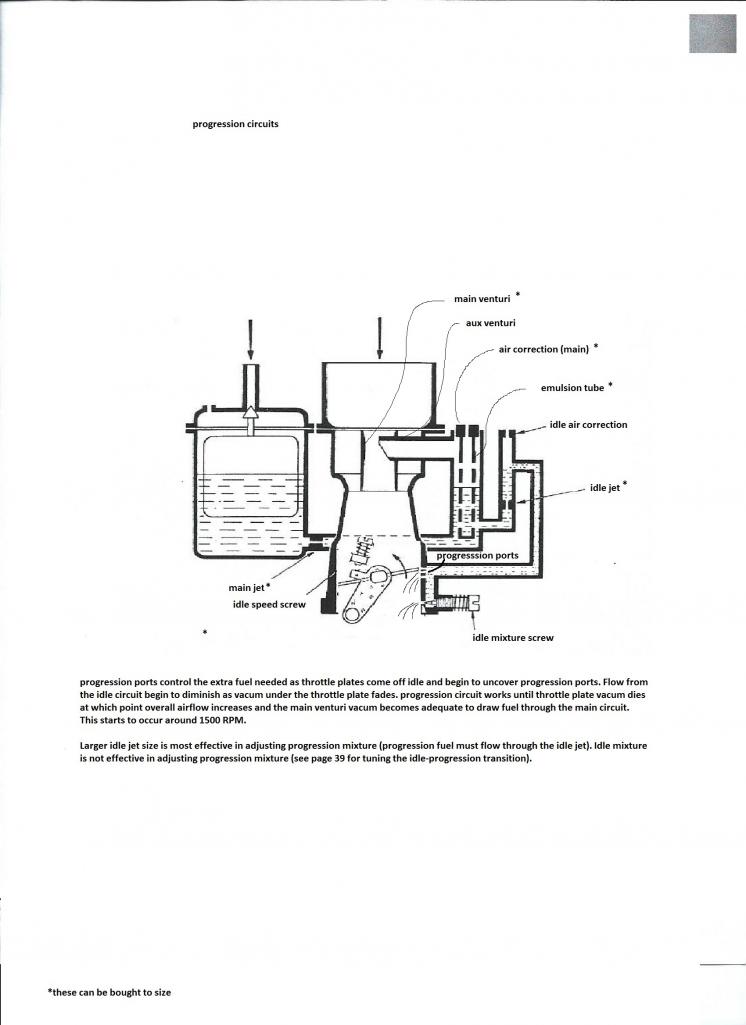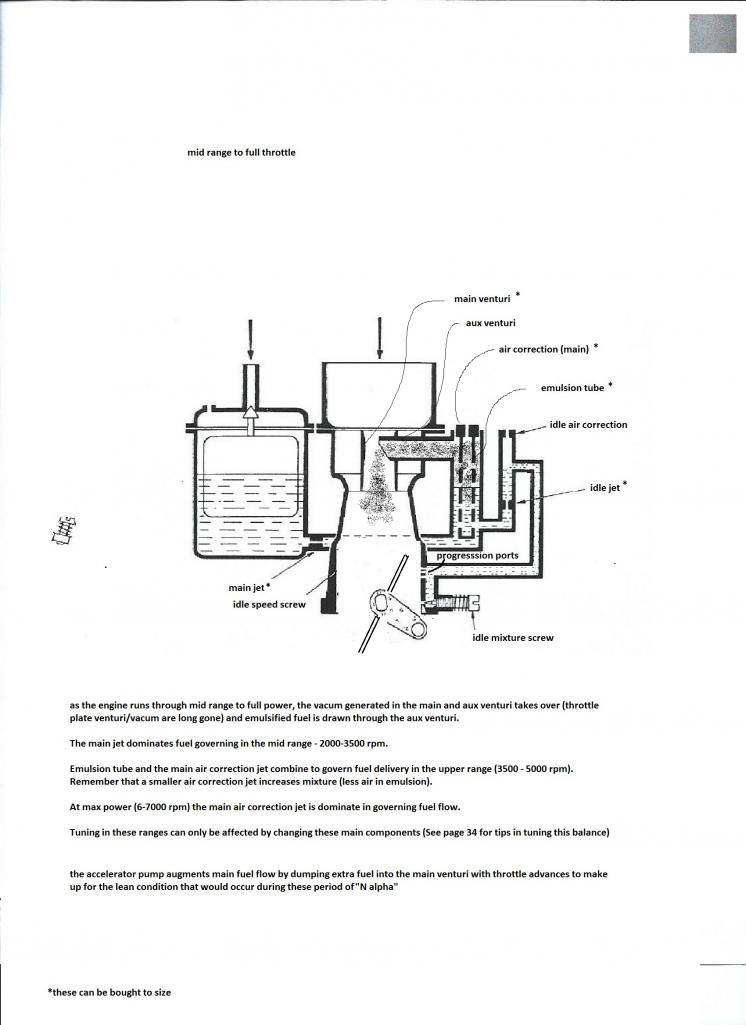|
|

|
Porsche, and the Porsche crest are registered trademarks of Dr. Ing. h.c. F. Porsche AG.
This site is not affiliated with Porsche in any way. Its only purpose is to provide an online forum for car enthusiasts. All other trademarks are property of their respective owners. |
|
|
  |
| 72hardtop |
 Oct 8 2018, 04:48 AM Oct 8 2018, 04:48 AM
Post
#21
|
|
Member   Group: Members Posts: 120 Joined: 11-September 13 From: Seattle/HB Ca./Fujieda-Japan Member No.: 16,378 Region Association: Pacific Northwest |
With regards to jetting....
If you're using a centrifugal only distributor shoot for 13:0 - 13:5 across the board. If you have a vacuum advance distributor you can go leaner but stay out of the 'Deathzone'....14:0 - 15:0 AFR zone At WOT. This is where EGT & CHT temps are the absolute highest. Go leaner than 15:0 and the temps are cooler than 13:0 or so (partial throttle). Ideally 15:5 - 17:0 at cruise speed light load/cracked/part throttle = GREAT MPG's! This can only be done with a vacuum advance distributor or mapped EFI set up. WOT = 100% load Load = Throttle position Part throttle = light load See where the EGT and CHT temps go beyond peak.... 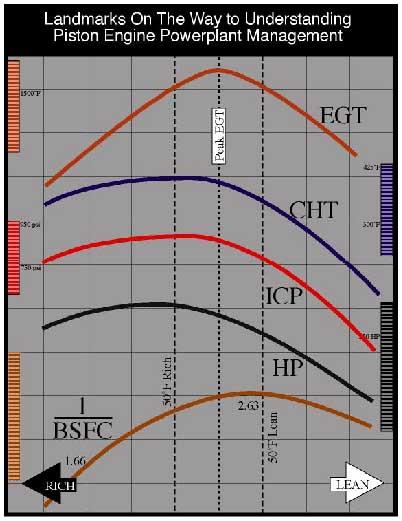 |
| gereed75 |
 Oct 8 2018, 08:20 AM Oct 8 2018, 08:20 AM
Post
#22
|
|
Senior Member    Group: Members Posts: 1,411 Joined: 19-March 13 From: Pittsburgh PA Member No.: 15,674 Region Association: North East States 
|
Hardtop,
that is a very good graph and if you understand it you are a long way towards understanding mixture control. A couple of problems though when trying to apply it to this automotive carbureted applications= With Weber’s there are only so many adjustments available to control mixture. Within the limits of these adjustments I see know way you could achieve lean of peak operations under part throttle/ light load conditions and then dependably transition back to rich of peak under load, no matter what kind of distributor you are running. We got no mixture control knob. With EFI you could program for lean of peak, but this ain’t EFI. That’s why you have to settle for 12.5 - 13.5 or so. As you know those AFR’s are all Rich of peak. I think we are ranging well beyond the scope of the original question |
| 914Toy |
 Oct 8 2018, 08:25 AM Oct 8 2018, 08:25 AM
Post
#23
|
|
Senior Member    Group: Members Posts: 746 Joined: 12-November 17 From: Laguna beach Member No.: 21,596 Region Association: Southern California 
|
Hi Toy914 and all, Did you use the Innovate "DLG-1 Dual Lambda (Air/Fuel Ratio) Gauge" with the 8 foot long leads? If so were the leads long enough to mount the gauges somewhere sensible? I need to do the same for my Corvair-powered 2.8L engine - which has O2 sensor bungs in each exhaust right at the back of the car. I'm running zenith 40TINS with 30mm chokes, running way too rich. May copy your jetting and see how I go. Your reply much appreciated, DaveO Yes, and here is where I placed the gauge. 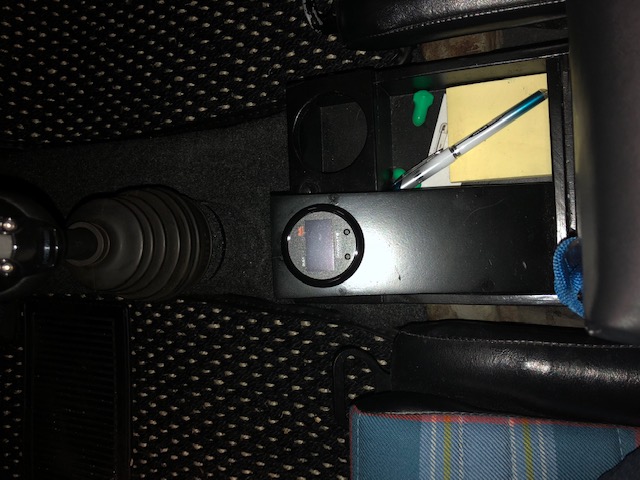 |
| 72hardtop |
 Oct 8 2018, 08:47 AM Oct 8 2018, 08:47 AM
Post
#24
|
|
Member   Group: Members Posts: 120 Joined: 11-September 13 From: Seattle/HB Ca./Fujieda-Japan Member No.: 16,378 Region Association: Pacific Northwest |
Hardtop, that is a very good graph and if you understand it you are a long way towards understanding mixture control. A couple of problems though when trying to apply it to this automotive carbureted applications= With Weber’s there are only so many adjustments available to control mixture. Within the limits of these adjustments I see know way you could achieve lean of peak operations under part throttle/ light load conditions and then dependably transition back to rich of peak under load, no matter what kind of distributor you are running. We got no mixture control knob. With EFI you could program for lean of peak, but this ain’t EFI. That’s why you have to settle for 12.5 - 13.5 or so. As you know those AFR’s are all Rich of peak. I think we are ranging well beyond the scope of the original question That's what makes them great they are very tune-able compared to stock carbs. You have more control over them. It all boils down to flow and knowing when one jet finishes and the next picks up. The distributor load senses. As the load increases (slight road increases) in a fixed throttle position flow decreases (timing backs off) but fuel rate stays steady. The flow thru the carb allows for the mix to richen as the airflow drops. And if you put your foot into it....it will richen further. This is not beyond the scope of the thread. Not at all. After tuning my 2056cc in my Westy it will with a cracked throttle hang 15.5-17 AFR or so on the highway. Any incline as the speed drops the AFR richens to 13 range. Give throttle to maintain speed....AFR holds highs 12's low 13's. Around town driving with part throttle light load cruise high 15-mid 16 AFR. Get into the throttle low 12's to 13. WOT 12-low 13's It is possible to do. Want a good read.... https://www.thesamba.com/vw/forum/viewtopic...hlight=wideband |
| jfort |
 Oct 8 2018, 09:32 AM Oct 8 2018, 09:32 AM
Post
#25
|
|
Senior Member    Group: Members Posts: 1,187 Joined: 5-May 03 From: Findlay, OH Member No.: 652 Region Association: Upper MidWest 
|
I have a recently completed 2.7 with DFI, PMOs, JEs at 10.8, and Dougherty cams DC30/Mod. Solex.
Info from build sheets: Manifold 40/36mm. Venturies 40/34. Main Jets 145. AC's 185. Idle Jets 50 (we changed the initial 55, tried 60). Idle Airs 130. E-Tubes F3. The DFI is set at 2° INIT, 25° 3000, 5° 8000. This was after Richard Parr and Jay Kjoller collaborated extensively. Runs great now. I understand about half of this, but I hope it helps. |
| gereed75 |
 Oct 8 2018, 09:54 AM Oct 8 2018, 09:54 AM
Post
#26
|
|
Senior Member    Group: Members Posts: 1,411 Joined: 19-March 13 From: Pittsburgh PA Member No.: 15,674 Region Association: North East States 
|
Hmmm. Interesting. Did not think that the Weber’s could do that.
Can’t say that I ever collected any data for sustained light load part throttle ops. I was only concerned with safe mixtures under load. Following your thought process, I would think that if your Weber’s are tuned to produce 13 AFR under load that they will intrinsically yield leaner mixtures under light loads part throttle. By there design, I Don’t see how you could have one without the other unless you were way off on jetting. Looks like good info in the samba thread- all 97 pages!! That will have to wait for another time. In the mean time - drive! |
| 72hardtop |
 Oct 8 2018, 10:37 PM Oct 8 2018, 10:37 PM
Post
#27
|
|
Member   Group: Members Posts: 120 Joined: 11-September 13 From: Seattle/HB Ca./Fujieda-Japan Member No.: 16,378 Region Association: Pacific Northwest |
Hmmm. Interesting. Did not think that the Weber’s could do that. Can’t say that I ever collected any data for sustained light load part throttle ops. I was only concerned with safe mixtures under load. Following your thought process, I would think that if your Weber’s are tuned to produce 13 AFR under load that they will intrinsically yield leaner mixtures under light loads part throttle. By there design, I Don’t see how you could have one without the other unless you were way off on jetting. Looks like good info in the samba thread- all 97 pages!! That will have to wait for another time. In the mean time - drive! What's to be avoided is 14:0 - 15.5:1 AFR WOT condition. Under 3/4 throttle positions there is not enough heat combined with load to be an issue. Even though the AFR is hotter than 13:1 16-17AFR is where you want to be during part throttle cruise (cracked throttle) for MPG's (vacuum advance distributor). And cooler running temps. Your foot dictates load. Even with a 009....which will run lean (jetted right) at ~14-15AFR no more (w/light throttle). With a cracked throttle (low load cond.) you will not be on the main circuit (even at 60+mph) You'll be on the idle/progression phase. |
| Larmo63 |
 Oct 8 2018, 10:47 PM Oct 8 2018, 10:47 PM
Post
#28
|
|
Advanced Member     Group: Members Posts: 4,267 Joined: 3-March 14 From: San Clemente, Ca Member No.: 17,068 Region Association: Southern California |
Earlier this year, I had a guy I know tune my Webers after 914Toy (Keith) and I futzed around with smaller chokes and different idle jets.
He got them pretty close and now I don't touch them. I'll probably screw them up if I do. (IMG:style_emoticons/default/driving.gif) |
| 72hardtop |
 Oct 8 2018, 10:54 PM Oct 8 2018, 10:54 PM
Post
#29
|
|
Member   Group: Members Posts: 120 Joined: 11-September 13 From: Seattle/HB Ca./Fujieda-Japan Member No.: 16,378 Region Association: Pacific Northwest |
Earlier this year, I had a guy I know tune my Webers after 914Toy (Keith) and I futzed around with smaller chokes and different idle jets. He got them pretty close and now I don't touch them. I'll probably screw them up if I do. (IMG:style_emoticons/default/driving.gif) Any idea what jet/s, vent size etc....? |
| gereed75 |
 Oct 9 2018, 09:10 AM Oct 9 2018, 09:10 AM
Post
#30
|
|
Senior Member    Group: Members Posts: 1,411 Joined: 19-March 13 From: Pittsburgh PA Member No.: 15,674 Region Association: North East States 
|
Spent some time with the Samba thread - very informative. you can get much of the benefit from that thread in the first 4 pages or so.
Yes it appears that the webers do produce mixtures over a much larger range than I thought. Nailing idle jets is still very important and difficult. Although my car runs pretty well, this reminds me that it could be better - alas this will be a project for another day. In the mean time I am confident that I am running with good AFR's in the critical 2/3's and above load conditions. Starts well, idles rock steady but probably richer than optimum in some regimes. Probably similar case to Toy and many others. The "published" jetting charts are pretty good, but fine tuning is probably necessary to be optimal for each motor, depending on ignition timing, cams, compression, piston type, fuel etc. Lots of good info here but is just a basis for further work. Thanks |
| Larmo63 |
 Oct 9 2018, 02:23 PM Oct 9 2018, 02:23 PM
Post
#31
|
|
Advanced Member     Group: Members Posts: 4,267 Joined: 3-March 14 From: San Clemente, Ca Member No.: 17,068 Region Association: Southern California |
2.4S spec Euro 7R block
36mm heads & manifolds Daugherty DC30 cams (between E and S spec) Here are my carb specs: Weber 40IDTPC3C & C1, we changed 34mm venturis 32mm venturis 60 idle jets 145 mains 140 air correction F26 emulsion I'm running the Clewett ignition system as well. This photo was taken while I was doing the wiring, so it doesn't appear finished. 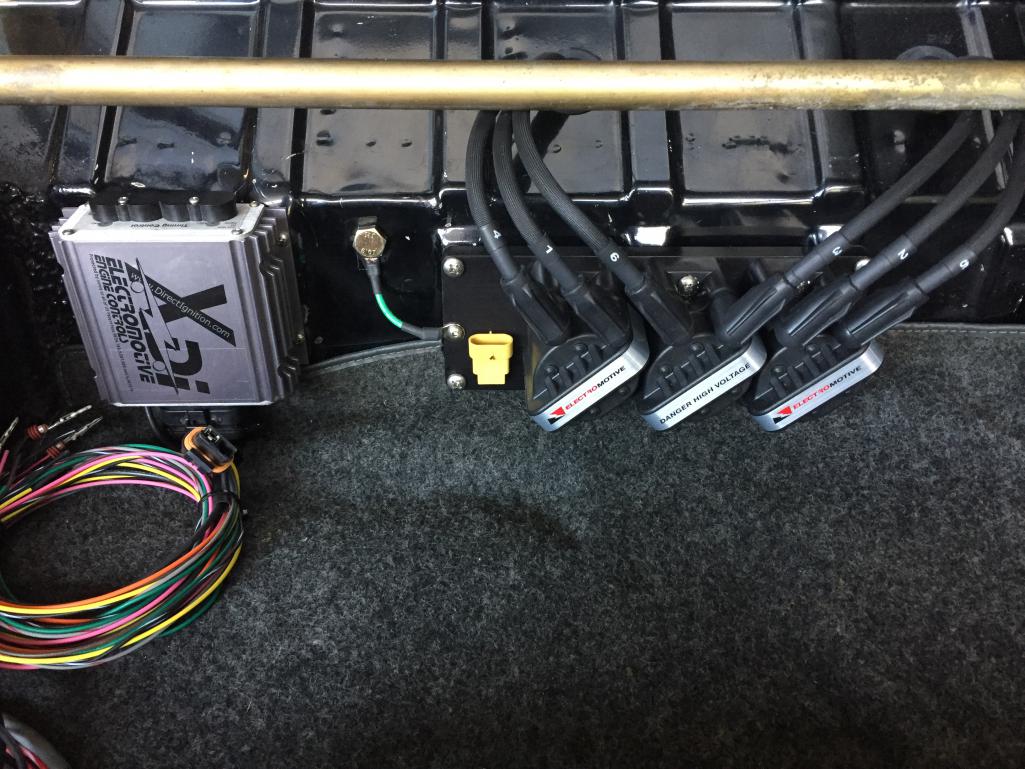 |
| Larmo63 |
 Oct 9 2018, 02:24 PM Oct 9 2018, 02:24 PM
Post
#32
|
|
Advanced Member     Group: Members Posts: 4,267 Joined: 3-March 14 From: San Clemente, Ca Member No.: 17,068 Region Association: Southern California |
|
| 72hardtop |
 Oct 9 2018, 04:22 PM Oct 9 2018, 04:22 PM
Post
#33
|
|
Member   Group: Members Posts: 120 Joined: 11-September 13 From: Seattle/HB Ca./Fujieda-Japan Member No.: 16,378 Region Association: Pacific Northwest |
Thanks for all the responses. After carefully adjusting all of the linkage, including the accelerator pump linkage ( to snug fit), I have settled at where I started with this thread except I have replaced the 60 idle jets with 55's, accepting the slightest hesitation with sudden acceleration some of the time. I now know 60's will eliminate all hesitation, but I prefer better fuel consumption, more power(?), and less potential for carbon build up. Engine on my test hill climb has a little more power and idle A/F's are a little better at high 10's. I may look for some drill bits to ream the 55' out to say 57. High 10's at idle? Get the idle jets down. You should be ~14AFR at idle There is no load at idle on the engine. The 14-15.5:1 AFR is to be avoided during high load (3/4 throttle or WOT) Cruising at an AFR of 16-17 is optimal and cooler running than 13:0 |
| gereed75 |
 Oct 9 2018, 06:53 PM Oct 9 2018, 06:53 PM
Post
#34
|
|
Senior Member    Group: Members Posts: 1,411 Joined: 19-March 13 From: Pittsburgh PA Member No.: 15,674 Region Association: North East States 
|
Larmo,
That is exactly what I am running on maybe the exact same motor. What pistons/compression are you running?? I have 9.5:1 with JE domed pistons, single plug, running about 30 degrees advance. I do get some spitting/sniffing at anytime and some backfire on deccel. Suspect I have some air leakage somewhere. Gaskets are all good and I thought the throttle shafts were tight when I set up the carbs per Performance Oriented guide, but who knows. How much of that do you get?? Thought maybe some is attributable to the cams. SWEET street motor huh!!! And I had no problem running with the Boxster/Cayman/SC/E36 crowd on track. |
| 72hardtop |
 Oct 9 2018, 11:48 PM Oct 9 2018, 11:48 PM
Post
#35
|
|
Member   Group: Members Posts: 120 Joined: 11-September 13 From: Seattle/HB Ca./Fujieda-Japan Member No.: 16,378 Region Association: Pacific Northwest |
Spent some time with the Samba thread - very informative. you can get much of the benefit from that thread in the first 4 pages or so. Yes it appears that the webers do produce mixtures over a much larger range than I thought. Nailing idle jets is still very important and difficult. Although my car runs pretty well, this reminds me that it could be better - alas this will be a project for another day. In the mean time I am confident that I am running with good AFR's in the critical 2/3's and above load conditions. Starts well, idles rock steady but probably richer than optimum in some regimes. Probably similar case to Toy and many others. The "published" jetting charts are pretty good, but fine tuning is probably necessary to be optimal for each motor, depending on ignition timing, cams, compression, piston type, fuel etc. Lots of good info here but is just a basis for further work. Thanks Easy enough to do.... Pull the main stacks out entirely....everything and run on the idle jets alone. Note on your tach when it falls on it's face. |
| 914Toy |
 Oct 10 2018, 02:03 PM Oct 10 2018, 02:03 PM
Post
#36
|
|
Senior Member    Group: Members Posts: 746 Joined: 12-November 17 From: Laguna beach Member No.: 21,596 Region Association: Southern California 
|
My engine is running well at all speeds, except for an occasional small hesitation when accelerating vigorously from idle, after changing from 60's to 55's idle jets. This change has helped increase idle A/F's from 10.4 to 11 at 800rpm. My idle air adjustment screws are several turns open, and air/fuel mixture screws are turned out only 1/4 turn.
So I am continuing trials and researching options to; 1) eliminate the occasional small hesitation when accelerating from idle, and 2) increasing the idle A/F ratio into the 12 to 13 range. 1) I am waiting for a set of "Hatchet" carb acceleration fuel pump cams, and a set of 175 air correction jets to replace the 180's installed, to address acceleration hesitation. 2) I have a range of idle jet sizes and have discovered that the idle jets that are 55's, 60's, or 65's (maybe even smaller and larger sizes) all have the same diameter side air inlet holes, that introduce air into the idle jet metered fuel, with this emulsified fuel mixture descending to the air/fuel mixture screws that control the volume of this fuel mixture into the carb throats. Thus, I conclude that if I replace the 55's in my carbs with 50's and open up the air /fuel mixture screws to regain lean best idle, this may result in a higher A/F ratio at idle. Comments? |
| gereed75 |
 Oct 10 2018, 03:22 PM Oct 10 2018, 03:22 PM
Post
#37
|
|
Senior Member    Group: Members Posts: 1,411 Joined: 19-March 13 From: Pittsburgh PA Member No.: 15,674 Region Association: North East States 
|
|
| 72hardtop |
 Oct 10 2018, 08:17 PM Oct 10 2018, 08:17 PM
Post
#38
|
|
Member   Group: Members Posts: 120 Joined: 11-September 13 From: Seattle/HB Ca./Fujieda-Japan Member No.: 16,378 Region Association: Pacific Northwest |
My engine is running well at all speeds, except for an occasional small hesitation when accelerating vigorously from idle, after changing from 60's to 55's idle jets. This change has helped increase idle A/F's from 10.4 to 11 at 800rpm. My idle air adjustment screws are several turns open, and air/fuel mixture screws are turned out only 1/4 turn. So I am continuing trials and researching options to; 1) eliminate the occasional small hesitation when accelerating from idle, and 2) increasing the idle A/F ratio into the 12 to 13 range. 1) I am waiting for a set of "Hatchet" carb acceleration fuel pump cams, and a set of 175 air correction jets to replace the 180's installed, to address acceleration hesitation. 2) I have a range of idle jet sizes and have discovered that the idle jets that are 55's, 60's, or 65's (maybe even smaller and larger sizes) all have the same diameter side air inlet holes, that introduce air into the idle jet metered fuel, with this emulsified fuel mixture descending to the air/fuel mixture screws that control the volume of this fuel mixture into the carb throats. Thus, I conclude that if I replace the 55's in my carbs with 50's and open up the air /fuel mixture screws to regain lean best idle, this may result in a higher A/F ratio at idle. Comments? Running Weber IDF's? IDF's start with combined with vacuum advance distributor. No lean tune cruising without one. 47.5 ilde jets 200 air corrector jets 120 main jets F11 tubes Float height 10mm - 11.5mm (ball not depressed gasket in place) Critical Float drop 28-32mm (less critical) Fuel pressure - no more than 3.5lbs (no dial regulator allowed) Critical Once the carbs are bench set you should start with no more than 1/2 in from contact with the idle speed screws. This is a starting point only. It will very likely run like a tractor initially. Opening to far and you will expose the 'progression circuit' Once it's running....LBI each screw to the smoothest highest idle speed with the air mixture screws. Once done...use a snail and check each carb (2 & 4). Note your idle speed (engine warm) bring high flow down to low flow carb. Now LBI each air mix screw again. Once done check carb sync. The same? If so now check idle speed get it to roughly 800 rom or so by bring each carb up slightly being sure to keep them synced until you reach idle speed. Now LBI each screw again. Once done check your carb sync again. If the same....Done. Now you can work on jetting. With regards to jetting start by driving around with only the idle jets (no main stacks installed) This allows you to see and feel when it falls on it's face. A bigger air corrector tips the main jet in sooner. A smaller air corrector delays the mains from coming in. |
| 914Toy |
 Oct 11 2018, 12:43 PM Oct 11 2018, 12:43 PM
Post
#39
|
|
Senior Member    Group: Members Posts: 746 Joined: 12-November 17 From: Laguna beach Member No.: 21,596 Region Association: Southern California 
|
After further research and inspection of the carbs, it seems logical to me, as suggested by some on PP, that the idle air jets are too small, as there is almost no change in A/F's when reducing the idle jets from 60's to 55's, which is actually a significant reduction in jet cross sectional area, about 14%. Thus I am considering drilling these air jets out a little as some others have done. The air jet holes are close to 1.3mm in diameter. What increase in diameter does anyone suggest?
|
| 72hardtop |
 Oct 11 2018, 03:40 PM Oct 11 2018, 03:40 PM
Post
#40
|
|
Member   Group: Members Posts: 120 Joined: 11-September 13 From: Seattle/HB Ca./Fujieda-Japan Member No.: 16,378 Region Association: Pacific Northwest |
After further research and inspection of the carbs, it seems logical to me, as suggested by some on PP, that the idle air jets are too small, as there is almost no change in A/F's when reducing the idle jets from 60's to 55's, which is actually a significant reduction in jet cross sectional area, about 14%. Thus I am considering drilling these air jets out a little as some others have done. The air jet holes are close to 1.3mm in diameter. What increase in diameter does anyone suggest? I'm against reaming jets. No matter how careful one is it never seems to work out well in the end. Your idle jet meters A/F during the progression phase. The mixture screws only adjust the A/F mixture when idling. No other time. Bigger air corrector brings mains in sooner smaller delays the mains. Best to pull the whole stack and drive with only the idle jets. You'll know exactly when it fall on it's face. Be conservative with the accel pump adjustment during this time. The graphs you posted to are a bit incorrect. The first graph say fuel enters main jet into idle circuit. That is incorrect. It enters the idle jet circuit. The main jet does not meter fuel for the idle jet or circuit. On IDF's the air entering the idle circuit flows in from the idle air bleed ports not idle air correction jets as the graph refers to. The main jet on IDF's is at the end of the emulsion tube. |
  |
1 User(s) are reading this topic (1 Guests and 0 Anonymous Users)
0 Members:

|
Lo-Fi Version | Time is now: 1st January 2026 - 11:11 AM |
Invision Power Board
v9.1.4 © 2026 IPS, Inc.









